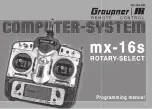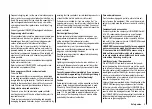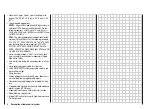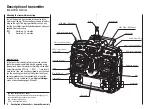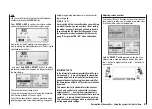
11
Receiver batteries
A wide variety of rechargeable 4.8 V NC and NiMH bat-
teries is available. For safety reasons do not use a batte-
ry box, and never use dry cells.
There is no direct method of checking receiver battery
voltage when operating a model.
Make it a standard part of your routine to check the
state of your batteries at regular intervals. Don’t
wait until you notice the servos running more slowly
than usual before recharging the packs.
Note:
Please refer to the main GRAUPNER FS catalogue for
full details of batteries, chargers, measuring equipment
and monitor units for checking batteries.
Charging the receiver battery
The charge lead, Order No.
3021
, can be connected di-
rectly to the NC receiver battery for charging. If the bat-
tery is installed in a model and you have installed one of
the following switch harnesses: Order No.
3046
,
3934
or
3934.1
or
3934.3
, the battery can be charged via the se-
parate charge socket, or the charge socket which is bu-
ilt into the switch. The switch on the switch harness must
be left at the “OFF” position for charging.
General notes on battery charging
• Observe the recommendations provided by the char-
ger manufacturer and the battery manufacturer at all
times. Observe the maximum permissible charge cur-
rent stated by the battery manufacturer.
The maximum charge current for the transmitter bat-
tery is 1.5 A. Limit the charge current to this value on
the charger.
• Carry out a series of test charges to ensure that the
automatic charge termination circuit works correctly
with your battery.
This applies in particular if you are using an auto-
matic charger designed for NiCd batteries to rechar-
ge the standard NiMH battery.
You may need to adjust the Delta Peak trigger volta-
ge, if your charger provides this option.
• Do not discharge the battery or carry out a battery
maintenance program via the integral charge socket.
The charge socket is not suitable for this application.
• Always connect the charge lead to the charger fi rst,
and only then to the transmitter or receiver batte-
ry. Observing this rule eliminates the danger of acci-
dental short-circuits between the bare contacts of the
charge lead plugs.
•
Never leave batteries on charge unsupervised.
Standard chargers
Order No.
6422
Minilader
2
Order No.
6427
Multilader
3
Order No.
6426
Multilader
6E*
Order No.
6428
Turbomat 6 Plus*
Order No.
6429
Turbomat 7 Plus*
Automatic chargers with special NiMH charge pro-
grams
Order No.
6419
Ultramat
5*
**
Order No.
6410
Ultramat 10*
Order No.
6412
Ultramat 12* **
Order No.
6414
Ultramat 14*
Order No.
6417
Ultramat 25* **
Order No.
6416
Ultra Duo Plus 30* **
* To recharge the mx-16s system you will also need the transmitter
charge lead, Order No.
3022
, and the receiver battery charge lead,
Order No.
3021
.
** 12 V power source required
Operating notes
Disposing of dry cells and rechargeable batteries
Never dispose of exhausted batteries in
the household rubbish. As end-user you
are legally required (by the “Battery Re-
gulation”) to return old and exhausted
batteries. They should and must be ta-
ken to your local toxic waste collection
point so that the materials can be re-
used or re-cycled. They can also be re-
turned to any retail outlet where batte-
ries are sold.
Please contact your local authority if you are not sure
where your nearest battery recycling centre is located.
Содержание MX-16S
Страница 1: ...1...
Страница 17: ...17...
Страница 31: ...31 Fixed wing models Installation and connections...
Страница 35: ...35 Program description Reserving a new memory...
Страница 47: ...47 Base settings Model helicopter...
Страница 83: ...83 Fail safe...
Страница 89: ...89 Programming examples Fixed wing model...
Страница 109: ...109 Programming examples Model helicopter...
Страница 112: ...112 112...
Страница 116: ...116...

